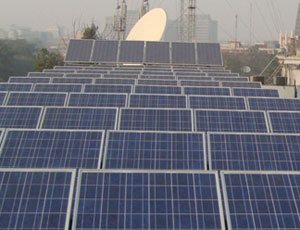India’s goal to achieve 20,000 MW of solar power by 2022 is proving to be a challenge as the industry awaits tweaks to a draft policy that will determine the tariff and allow the country to import photovoltaic cells—a technology that is not established in the country. But the road bumps haven’t stopped the development of some solar facilities in the country.

While the country currently has almost no grid-connected solar power, a recent McKinsey& Co. survey ranks India as the most attractive destination in the world for solar PV manufacturing and generation.
The Jawaharlal Nehru National Solar Mission’s goal is to have a policy in place to encourage solar PV as well as 1,000 MW of grid-connected solar power generation by 2013. An additional 3,000 MW would be added by 2017 through the mandatory use by utilities of the renewable purchase obligation.
“The transition could be appropriately upscaled, based on availability of international finance and technology,” according to the mission statement.
Opportunities in the sector already are being tapped by engineering, procurement and construction professionals in the solar PV arena, and partnerships have been struck with international companies. Suniva Inc., a U.S. manufacturer of mono-crystalline silicon solar cells and modules, in partnership with Titan Energy Systems, India, recently commissioned a 3-MW, ground-mounted system—the largest solar power installation in India and located in the southern state of Karnataka—covering 12 acres. Titan designed the solar project incorporating Suniva’s propriatary solar cells and provided engineering, procurement and construction services.
“This project exemplifies Titan’s ability to execute large-scale solar projects quickly and cost-effectively, which are key measures of success in rapidly growing solar markets like India,” says John Baumstark, CEO of Suniva. The system is owned and operated by Karnataka Power Corp. Ltd., which will distribute power generated by the system to local farmers for irrigation purposes..
Refex Energy of India and Germany’s IBC Solar have signed a memorandum of understanding with the state of Gujarat to design, supply, implement and maintain a 50-MW solar power project. The project is waiting on the government to finalize its policy on tariffs.
There has been a marked preference for solar PV versus solar thermal. “We have no plan to get into solar thermal as solar PV technology is proven in India. While we do realize that land is required—1 MW generation requires four acres—in contrast, we do not require water, turbine sheds, etc.,” according to a Titan Energy Systems spokesperson.
The Ministry of New and Renewable Energy Minister Farooq Abdullah said in parliament last month that the Solar Thermal Federation of India, which includes 14 solar manufacturers, has said only 18.7 million sq. meters of solar-thermal collector area by 2022 is possible—not the solar mission target of 20 million sq. m.
“PV is here. There are still many large issues in terms of contractual obligations and payment security arrangements not in place. While tariffs look attractive, down the line they will have to be reduced,” says Anish De, CEO, consultancy firm Mercados EMI Asia, speaking of the work yet to be done on the nation’s solar policy.


Post a comment to this article
Report Abusive Comment